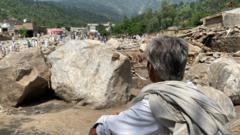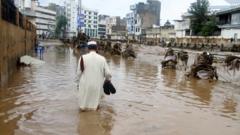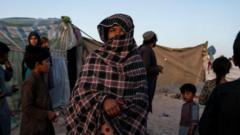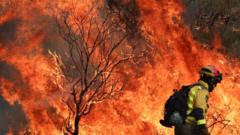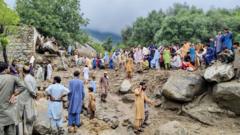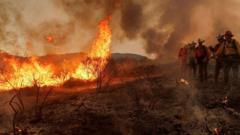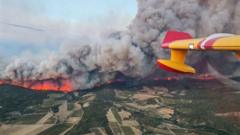In the wake of devastating monsoon floods in Pakistan, over 200 individuals remain missing in the Buner district, while more than 300 lives have already been claimed by the disaster. Climate change is intensifying these catastrophic weather events, prompting government officials to declare multiple areas as disaster zones.
Over 200 Individuals Still Missing in Catastrophic Flooding in Pakistan's Buner District
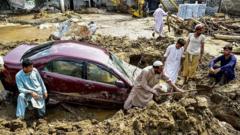
Over 200 Individuals Still Missing in Catastrophic Flooding in Pakistan's Buner District
Official reports indicate a tragic toll from recent monsoon floods across Pakistan, with fatalities exceeding 300 and many more unaccounted for.
In the north-western region of Pakistan, flash floods have caused widespread destruction, with at least 209 individuals currently reported missing in the Buner district alone. The tragic impact of the floods has led to over 300 confirmed deaths across Pakistan and Pakistan-administered Kashmir. According to a local official, Jehangir Khan, the rescue efforts have faced significant challenges, with eight unidentified bodies buried due to the absence of surviving family members to claim them.
The destruction of roads and infrastructure has further hindered recovery efforts, leaving many relatives unable to access the remains of their loved ones. Reports indicate that up to a dozen villages have been partially buried, complicating rescue operations even further. Asfandyar Khattak, the head of the provincial disaster management authority, has also confirmed that many individuals are unaccounted for in the Shangla district.
These catastrophic floods, which coincide with the heightened monsoon rains typical of the June to September season in South Asia, have been exacerbated by climate change, leading to increased intensity and frequency of such weather events. Recently, Indian-administered Kashmir also faced severe flooding, resulting in at least 60 fatalities. Additional losses were reported in Pakistan-administered Kashmir and the northern Gilgit-Baltistan region amid the relentless rainfall.
For the year, Pakistan's monsoon season has already claimed nearly 650 lives, with government meteorologists predicting continued heavy rainfall in the affected north-west regions until August 21. The monsoon rains typically account for three-quarters of South Asia's annual precipitation, and this year saw a staggering 73% increase in rainfall in Punjab compared to the previous year, underscoring the mounting toll on human life and infrastructure.
Glaciologists warn that melting glaciers due to climate change are adding to the risks by destabilizing mountainous regions and contributing to landslides. While the precise causes of the current flooding remain under investigation, it is clear that the interplay of these factors has resulted in a tragic humanitarian crisis for many communities throughout Pakistan.
The destruction of roads and infrastructure has further hindered recovery efforts, leaving many relatives unable to access the remains of their loved ones. Reports indicate that up to a dozen villages have been partially buried, complicating rescue operations even further. Asfandyar Khattak, the head of the provincial disaster management authority, has also confirmed that many individuals are unaccounted for in the Shangla district.
These catastrophic floods, which coincide with the heightened monsoon rains typical of the June to September season in South Asia, have been exacerbated by climate change, leading to increased intensity and frequency of such weather events. Recently, Indian-administered Kashmir also faced severe flooding, resulting in at least 60 fatalities. Additional losses were reported in Pakistan-administered Kashmir and the northern Gilgit-Baltistan region amid the relentless rainfall.
For the year, Pakistan's monsoon season has already claimed nearly 650 lives, with government meteorologists predicting continued heavy rainfall in the affected north-west regions until August 21. The monsoon rains typically account for three-quarters of South Asia's annual precipitation, and this year saw a staggering 73% increase in rainfall in Punjab compared to the previous year, underscoring the mounting toll on human life and infrastructure.
Glaciologists warn that melting glaciers due to climate change are adding to the risks by destabilizing mountainous regions and contributing to landslides. While the precise causes of the current flooding remain under investigation, it is clear that the interplay of these factors has resulted in a tragic humanitarian crisis for many communities throughout Pakistan.

